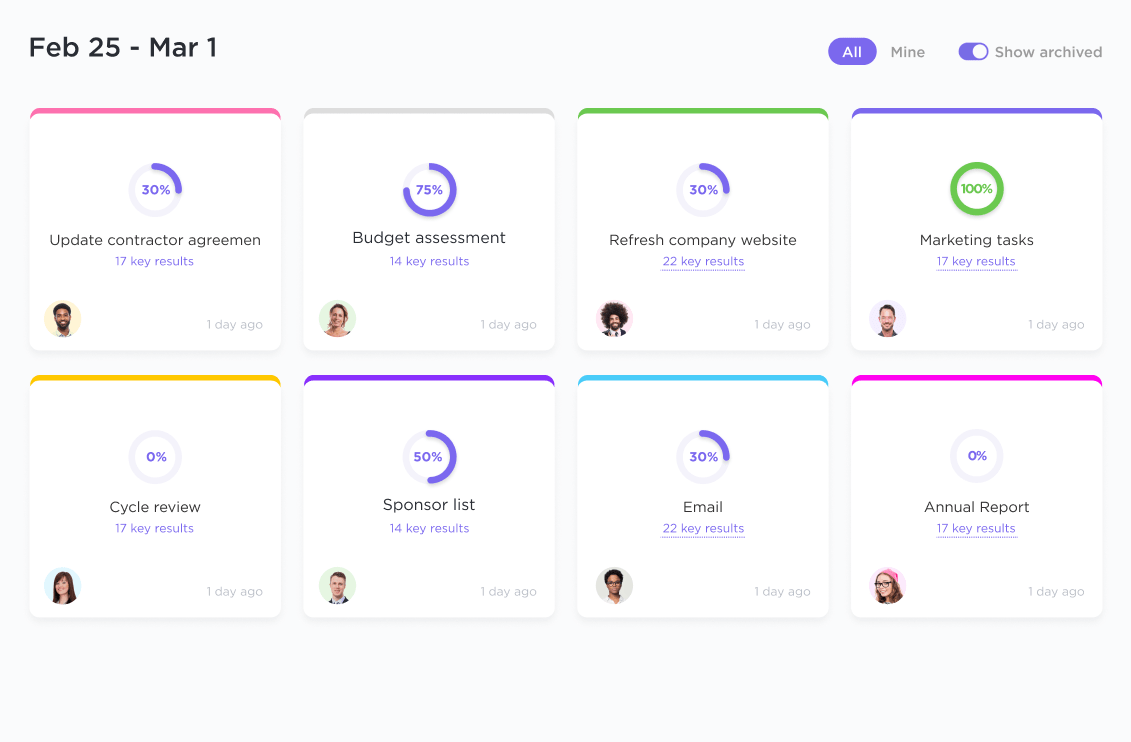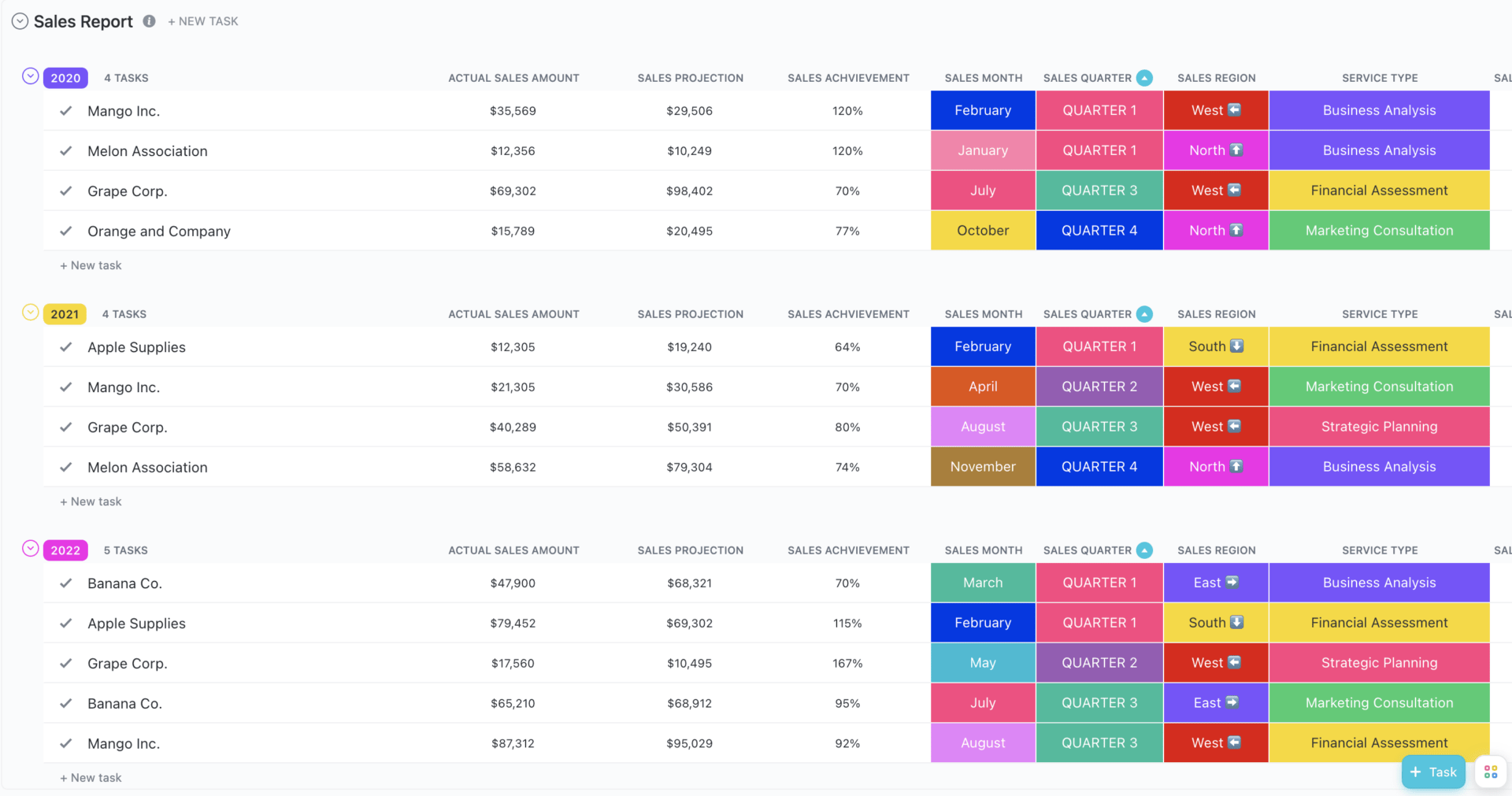مندوبو المبيعات ينفقون فقط 36% من وقتهم في البيع، أو ما يزيد قليلاً عن ساعتين في اليوم
أما باقي وقتهم فيقضونه في المهام اليومية الضرورية مثل اجتماعات الفريق أو فرز الأدوات التقنية المختلفة أو تحديث أنظمة إدارة علاقات العملاء يدويًا.
تخيّل مقدار الإيرادات الإضافية التي ستحققها كل شهر إذا تم الاهتمام بهذه الممارسات اليدوية.
هذا هو المكان الذي يمكن أن تساعد فيه برمجيات إدارة المشاريع كلاً من محترفي المبيعات ومديري المشاريع. يمكن أن يساعد دمج استراتيجيات إدارة المشاريع الأساسية في عمليات المبيعات مديري المبيعات:
- تبسيط تتبع العملاء المحتملين
- تعزيز دقة التنبؤ بالمبيعات
- تسريع دورة المبيعات
لذا، فإن إدارة مشاريع المبيعات تؤدي في النهاية إلى زيادة الإيرادات ورضا العملاء.
هل تريد أن ترى كيف يمكن لهذه الأساسيات أن تحول عمليات المبيعات لديك؟ دعنا ندخل في ذلك.
فوائد إدارة مشاريع المبيعات
إن تطبيق برنامج إدارة المشاريع في استراتيجيات المبيعات الخاصة بك له فوائد ملموسة لفريق المبيعات لديك. إليك نظرة سريعة على أهم خمس فوائد:
- تحديد واضح للأهداف: عندما يتشارك الجميع في فهم الهدف، يصبح تحقيق الأهداف أسهل. تخيل أن يبدأ فريقك كل شهر بأهداف مشروع واضحة المعالم ومقسمة حسب المنطقة والمنتج. هذا الوضوح يمنع الارتباك ويحافظ على تركيز الجميع على نفس الهدف النهائي.
- تحسين التعاون: تشجع الإدارة الفعالة للمشاريع فرقك، مثل المبيعات والتسويق ودعم العملاء وما إلى ذلك، على التعاون بسلاسة. على سبيل المثال، تمكّن أدوات إدارة مشاريع المبيعات من التواصل بشكل أفضل، بحيث يعرف التسويق بالضبط أنواع العملاء المحتملين الذين تحتاجهم المبيعات، ويمكن للمبيعات تقديم ملاحظات في الوقت الفعلي. وهذا قد يعني تأهيل العملاء المحتملين بشكل أسرع ومواد تسويقية تلقى صدى حقيقيًا لدى العملاء المحتملين.
- التخصيص الذكي للموارد: إن معرفة مكان تخصيص مواردك يمكن أن يحدث فرقًا كبيرًا. لنفترض أن لديك عميلاً ذا قيمة عالية يحتاج إلى مزيد من الاهتمام. تساعدك إدارة مشروع المبيعات على ضبط عبء عمل فريقك حتى يتمكن أفضل موظفيك من رعاية هذا العميل المحتمل أو العلاقة الرئيسية دون إهمال عملائهم الآخرين.
- إدارة أفضل للوقت: باستخدام أدوات إدارة المشاريع، يمكن لفريقك تنظيم مهامهم اليومية بشكل أكثر فعالية، مما يضمن عدم إهمال أي شيء. تخيل استخدام أداة لإدارة المشاريع تنبه مندوب المبيعات عندما يحين وقت المتابعة مع عميل محتمل أو تجديد عقد. ستبقي عملية المبيعات على المسار الصحيح وبكفاءة. أدوات تتبع الوقت في منصات إدارة المشاريع مثل ClickUp يمكن أن تُظهر أيضًا لمندوبي المبيعات أين يتم استغلال وقتهم بشكل زائد أو ناقص.
- المساءلة: يساعد اعتماد إدارة المشاريع في المبيعات على بناء المساءلة من خلال تحديد أدوار ومسؤوليات واضحة. عندما يتم تعيين فرص المبيعات وتتبعها كمهام فردية، يشعر أعضاء الفريق بإحساس أكبر بالمسؤولية والملكية في إدارة مشاريع المبيعات. كما أنها تتيح أيضاً تقديم ملاحظات بناءة والتحسين المستمر. على سبيل المثال، يمكن أن تساعد مراجعة جميع الفرص الضائعة المغلقة في تحديد مجالات التحسين لفريقك.
المكونات الرئيسية لإدارة مشاريع المبيعات
لإتقان إدارة مشاريع المبيعات، من الضروري إتقان بعض المكونات الأساسية. دعنا نفصل ما الذي يجعل هذا النهج ناجحاً وكيف يمكنك تطبيقه بفعالية.
1. وضع أهداف وغايات واضحة
ابدأ كل مشروع بتحديد شكل النجاح. حدد بوضوح أهداف المبيعات والأهداف حتى يعرف الجميع ما الذي يعملون من أجله. هذه المواءمة هي أساس الإدارة الفعالة لمشروع المبيعات وتضمن أن جميع أعضاء الفريق يسعون لتحقيق نفس النتائج.
على سبيل المثال، إذا كنت تبيع برامج تسويق جديدة للشركات، فقد يكون الهدف الواضح هو تأمين 30 عقدًا جديدًا خلال الربع المالي التالي. هذا الهدف قابل للقياس ويوفر هدفًا لفريق المبيعات.
2. خطط لأهدافك واستراتيجيتك
قسّم استراتيجية المبيعات الخاصة بك إلى مراحل رئيسية قابلة للتنفيذ. بهذه الطريقة، يمكنك تتبع التقدم المحرز خطوة بخطوة وإجراء التعديلات حسب الحاجة. يساعدك التخطيط على الالتزام بالجدول الزمني ويحافظ على تحفيز الفريق من خلال الاحتفال بالمكاسب الصغيرة على طول الطريق.
استمرارًا لمثال مبيعات البرمجيات، يمكن أن يكون أحد المعالم البارزة هو تحقيق 100 عميل محتمل مؤهل خلال الشهر الأول. هذه خطوة قابلة للتنفيذ نحو الهدف العام المتمثل في تأمين العقود.
3. إدارة المخاطر بشكل استباقي
تحديد المخاطر المحتملة في وقت مبكر من المشروع. سواء كانت تغيرات السوق، أو عدم القدرة على التنبؤ بالعميل، أو التحديات الداخلية، فإن وجود خطة للتخفيف من هذه المخاطر يُبقيك مستعدًا وسريع الاستجابة، مما يقلل من فرص خروج المشروع عن مساره.
لنفترض أن أحد المنافسين يطلق برنامجًا مشابهًا بميزات أكثر تقدمًا. يمكن أن تتضمن خطة التخفيف من هذه المخاطر عروضًا أقوى تسلط الضوء على سهولة استخدام برنامجك وبساطته أو ميزات أخرى مميزة.
4. إنشاء قنوات اتصال فعالة
ضمان بيئة تعاونية حيث يمكن للجميع مشاركة التحديثات وطرح الأسئلة والوصول إلى المعلومات المهمة بسهولة. يساعد إنشاء قنوات اتصال فعالة ومفتوحة مثل الاجتماعات المنتظمة أو مساحات العمل الرقمية المشتركة أو مجموعات المراسلة الفورية في الحفاظ على الوضوح والاستمرارية عبر الفريق.
💡 نصيحة احترافية: استخدم نقر فوق عرض الدردشة مع تطبيقات شائعة مثل Slack وGoogle Drive وSalesforce وHubSpot وZoom وDropbox وغيرها. يمكنك توصيل تطبيقاتك المفضلة والاستمرار في استخدامها داخل نظام ClickUp البيئي
ClickUp: منصة إدارة مشروعات المبيعات متعددة الاستخدامات ClickUp لفرق المبيعات يتفوق في المزج بين المبيعات وإدارة المشاريع، مما يمكّن مدير مشروع المبيعات من الإشراف على مشروع المبيعات من البداية وحتى تسليم المشروع. وهو يجلب جميع الأدوات اللازمة مثل
برنامج B2B CRM , أدوات تمكين المبيعات والتحليلات وإدارة المهام والتواصل والمزيد تحت سقف واحد.
دعنا نلقي نظرة مفصّلة على كيفية تعزيز ClickUp لإدارة مشاريع المبيعات الخاصة بك:
1. برنامج إدارة علاقات العملاء (CRM)
مع ClickUp CRM نظام، يمكنك تنظيم جميع تفاعلات ومعلومات العملاء في مكان واحد. وهو يتيح للفرق إدارة وتتبع خط أنابيب المبيعات بفعالية من خلال طرق عرض قابلة للتخصيص مثل القوائم ولوحات كانبان والجداول.
تُمكِّن طرق العرض هذه فرق المبيعات من تصور خط سير المبيعات ومراقبة التقدم المحرز وتحديد أولويات المهام. تساعد الحقول المخصصة في تتبع التفاصيل الأساسية مثل حالة العميل المحتمل وحجم الصفقة وتفاعلات العملاء، مما يضمن عدم إغفال أي معلومات. يتيح لك نظام إدارة جهات الاتصال في ClickUp تنظيم بيانات العملاء وتحليلها بدقة، مما يسهل إدارة العلاقات بشكل أفضل.
من خلال أتمتة المهام الروتينية وتوفير أدوات قوية لإدارة خطوط الأنابيب، يعزز ClickUp CRM إنتاجية فريق المبيعات وكفاءته.
💡 نصيحة احترافية: _أتمتة مهام المتابعة باستخدام
/href/ https://clickup.com/features/automations ClickUp Automations /%%href/
_لضمان الردود على العملاء المحتملين في الوقت المناسب والحفاظ على سير خط أنابيب المبيعات بكفاءة

قم بإدارة عملائك المحتملين وعلاقاتك بالعملاء ومخططات المبيعات في مكان واحد مع ClickUp CRM
2. أدوات التحليلات
توفر أدوات التحليلات الخاصة ب ClickUp رؤى في الوقت الفعلي حول مؤشرات الأداء الرئيسية للمبيعات والأداء وتقدم الصفقات وإنتاجية الفريق. مع لوحات معلومات ClickUp يمكنك تصور اتجاهات البيانات وتتبع أداء الفريق وإنتاجيته وقياس النجاح مقابل الأهداف.
بالإضافة إلى ذلك، يقدم ClickUp تقارير قابلة للتخصيص يمكنك تخصيصها حسب احتياجاتك الخاصة. يتكامل أيضًا مع العديد من أدواتك اليومية مثل Salesforce و Zoho، مما يعزز قدرتك على تتبع بيانات المبيعات وتحليلها .
وتساعد هذه التحليلات كلاً من قادة المبيعات ومديري المشاريع على اتخاذ قرارات قائمة على البيانات، وتحديد الاختناقات، وحل المشاكل بسرعة، وتعديل الاستراتيجيات لتحسين النتائج. يسمح فهم هذه المقاييس للفرق بتحسين عمليات المبيعات باستمرار ويضمن توافقها مع أهداف العمل الأوسع نطاقاً.

صمم لوحة معلومات مخصصة خاصة بك وأضف مؤشرات الأداء الرئيسية للمبيعات
3. إدارة مركزية للمهام
مع مهام النقر فوق المهام يمكنك تقسيم أي مشروع مهما كان حجمه إلى مهام أصغر يمكن إدارتها. ويساعد ذلك مندوبي المبيعات على إدارة كل شيء بدءاً من تتبع العملاء المحتملين الأولي وحتى الإغلاق النهائي للصفقة بطريقة منظمة.
يمكن تصميم كل مهمة لتناسب الاحتياجات المحددة لعملية المبيعات، مما يضمن مراعاة كل التفاصيل. على سبيل المثال، يمكنك إضافة حقول مخصصة مثل "حجم المؤسسة" أو "الميزانية" لالتقاط معلومات محددة.

استخدام الحقول المخصصة لإضافة تفاصيل مهامك في ClickUp لمساعدة فريقك في الحصول على نظرة عامة كاملة
4. تكامل المستندات والذكاء الاصطناعي مستندات ClickUp مفيدة بشكل خاص لمندوبي المبيعات الذين يحتاجون إلى الوصول إلى مستندات العروض التقديمية أو العقود أو الخطط الاستراتيجية بسرعة. فوجود جميع المستندات ذات الصلة مرتبطة مباشرةً بالمهام ذات الصلة يعني سرعة التحضير للاجتماعات والعروض التقديمية,
تعزيز الإنتاجية الإجمالية .
بالإضافة إلى ذلك, انقر فوق الدماغ يعزز هذا التكامل من خلال توفير رؤى وأتمتة تعتمد على الذكاء الاصطناعي. يمكن لمندوبي المبيعات استخدامه لطرح أسئلة حول المستندات، وتلقي ملخصات فورية للمحتويات، وحتى إنشاء ملاحظات الاجتماعات أو الخطوط العريضة للعروض التقديمية.

إنشاء وثائق مبيعات شاملة بمساعدة مستندات ClickUp Docs و ClickUp Brain
اقرأ أيضًا:_% كيفية استخدام الذكاء الاصطناعي في المبيعات
5. تتبع الأهداف أهداف ClickUp يُمكِّن فرق المبيعات من تتبع عملهم مقابل أهداف استراتيجية ذات أهداف قابلة للقياس. وهذا أمر بالغ الأهمية بالنسبة للمبيعات حيث يمكن ربط النتائج بأهداف محددة، مثل أهداف المبيعات الفصلية أو أهداف اكتساب العملاء.

تتبع أهداف مبيعاتك الإجمالية والتقدم الذي أحرزه كل مندوب مبيعات بسهولة باستخدام ClickUp
6. أدوات التعاون المرئي كليك أب السبورات البيضاء تجعل أفكار الفريق تنبض بالحياة، مما يسهل التعاون المرئي المثالي لوضع استراتيجيات عروض المبيعات أو تخطيط مسارات المبيعات. تساعد هذه الأدوات الفرق على العصف الذهني بطريقة ديناميكية وجذابة، مما يسهل تطوير استراتيجيات المبيعات وتحسينها.

تعيين المستخدمين والمهام باستخدام ClickUp Whiteboards
7. قوالب خاصة بالمبيعات قابلة للتخصيص
يمكن أن تقلل القوالب بشكل كبير من الوقت المستغرق في المهام المتكررة وتساعد في الحفاظ على نهج قياسي للأنشطة المتعلقة بالمبيعات. تقدم ClickUp العديد من القوالب الخاصة بالمبيعات، مثل قوالب خطة المبيعات لتبسيط العمليات عبر أنشطة فريقك. دعنا نلقي نظرة على بعض هذه النماذج:
a. قالب خطة مبيعات ClickUp
ضع أهداف مبيعات واضحة وقابلة للتنفيذ من خلال نموذج خطة المبيعات القابل للتخصيص بالكامل
نموذج قالب خطة مبيعات ClickUp مثالي لوضع أهداف مبيعات واضحة وقابلة للتنفيذ. إنه سهل الاستخدام للمبتدئين، وقابل للتخصيص بالكامل، وجاهز للاستخدام في ثوانٍ. يساعدك هذا النموذج على هيكلة استراتيجية المبيعات الخاصة بك، وتتبع الأداء، والتكيف حسب الحاجة. وهذا يضمن أن يظل فريقك متسقًا ومركزًا على تحقيق الأهداف المحددة.
b. قالب خط أنابيب المبيعات ClickUp
قم بتبسيط عملية المبيعات الخاصة بك من تأهيل العملاء المحتملين إلى تحويل الصفقات من خلال قالب خط أنابيب المبيعات الخاص بنا
نموذج قالب خط أنابيب المبيعات ClickUp مصمم لإدارة عملية المبيعات بكفاءة بدءًا من تأهيل العملاء المحتملين وحتى تحويل الصفقات. يوفر هذا القالب الجاهز للاستخدام والقابل للتخصيص بالكامل نهجًا منظمًا لتتبع العملاء المحتملين وإدارة الصفقات. وبفضل الميزات التي تتيح إطار عمل متسق للتأهيل وعملية تحويل الصفقات، فقد تم تصميمه لتعزيز أداء مبيعاتك.
c. قالب تقرير مبيعات ClickUp
تتبع أداء مبيعاتك وتصوره بفعالية من خلال قالب تقرير المبيعات الشامل الخاص بنا
نموذج قالب تقرير مبيعات ClickUp يوفر نهجاً شاملاً لتتبع المبيعات الشهرية أو الفصلية أو السنوية. يساعدك على مراقبة تقدم أنشطة المبيعات الخاصة بك بشكل فعال. ويتيح لك تنظيم المقاييس الرئيسية عبر الأقسام، وتصور اتجاهات المبيعات من خلال الرسوم البيانية المختلفة، وتحديد مجالات التحسين. تتضمن بعض ميزاته الرئيسية حالات مخصصة لتتبع التقدم المحرز، وحقول مخصصة لتصنيف البيانات التفصيلية، وطرق عرض متعددة مثل تقارير المبيعات السنوية والشهرية.
## أفضل الممارسات لإدارة مشاريع المبيعات
لإبقاء مشروع المبيعات الخاص بك على المسار الصحيح مع الحفاظ على توافق فرق العمل لديك، تحتاج إلى اعتماد بعض تقنيات إدارة مشاريع المبيعات وأفضل الممارسات. إليك كيفية تطبيق هذه الممارسات بفعالية لإدارة مشروع مبيعاتك بنجاح:
1. اجعل معلوماتك مركزية
احتفظ بجميع معلومات مشروعك في مكان واحد. يؤدي ذلك إلى إنشاء مستودع مركزي حيث يمكنك أنت وفريقك الوصول إلى بيانات العميل وتحديثات المشروع ومقاييس الأداء. هذا النهج:
- يمنع انغلاق المعلومات
- يضمن أن يكون الجميع على نفس الصفحة
- يسمح باتخاذ قرارات سريعة بناءً على بيانات دقيقة ومحدثة
للقيام بذلك، تحتاج إلى
- استخدام أداة لإدارة المشروع مثل ClickUp لتخزين جميع البيانات المتعلقة بالمشروع
- تشجيع أعضاء الفريق على تحديث معلومات المشروع مباشرةً بعد الاجتماعات أو التفاعلات مع العملاء للحفاظ على تحديث البيانات
- قم بإعداد أذونات لضمان حماية المعلومات الحساسة مع إتاحة الوصول إليها لمن يحتاجها
2. إنشاء سجل لأصحاب المصلحة
اعرف من هم المشاركون في مشروعك وما هي أدوارهم. يساعدك إنشاء سجل لأصحاب المصلحة على تتبع اهتمامات الجميع ومشاركتهم وتأثيرهم. بالنسبة لمشاريع المبيعات، هذا يعني فهم من يؤثر داخل شركتك على القرارات ومن يتفاعل مباشرة مع العملاء والعملاء المحتملين.
💡 نصيحة احترافية:
/href/ https://clickup.com/blog/stakeholder-mapping-templates// إنشاء خرائط أصحاب المصلحة /%%href/
_وأدوات بصرية أخرى لفهم وعرض العلاقات ومستويات التأثير لمختلف أصحاب المصلحة الرئيسيين
3. توثيق الأهداف المشتركة
تأكد من أن كل شخص في خطة المشروع أو الفريق يعرف الأهداف المشتركة. يساعد توثيق أهداف المشروع المشتركة على مواءمة جهود فريقك ويوفر معيارًا لـ قياس نجاح المشروع، وقد يعني ذلك تحديد أهداف واضحة لاكتساب العملاء أو معدلات الاحتفاظ بهم أو أهداف الإيرادات في المبيعات. إن وجود هذه الأهداف الموثقة يسهل على الجميع الحفاظ على تركيزهم وتحفيزهم.

أنشئ أهداف المبيعات الأسبوعية والمزيد على ClickUp
4. وضع خطة عمل مشتركة
ضع خطة عمل يتفق عليها الجميع. يجب أن تحدد هذه الخطة كل خطوة من خطوات عملية المبيعات وتعيين المسؤوليات وتحديد المواعيد النهائية. تضمن خطة العمل المشتركة عدم التغاضي عن أي مهمة وأن يعرف كل عضو في الفريق أدواره المحددة والمواعيد النهائية. إليك بعض أفضل الممارسات في هذا الشأن:
- قسّم الأهداف الرئيسية إلى مهام أصغر يمكن إدارتها مع تحديد المسؤوليات الموكلة إليها
- تحديد مواعيد نهائية واضحة وإدراج فترات احتياطية للتأخيرات غير المتوقعة
- التأكد من تخصيص الموارد اللازمة لجميع المهام، من القوى العاملة إلى الأدوات والميزانية
5. الحفاظ على التواصل المنتظم
أبقِ خطوط التواصل مفتوحة. تساعد التحديثات المنتظمة، سواء من خلال الاجتماعات أو رسائل البريد الإلكتروني أو المراجعات السريعة، في إبقاء الجميع على اطلاع على تقدم المشروع والمشكلات الناشئة.
بالنسبة لقسم المبيعات، يمكن أن يعني التواصل المتسق والشفاف الفرق بين تفويت الفرص واغتنامها، حيث يضمن ذلك الاستجابة في الوقت المناسب لتغيرات السوق واحتياجات العميل.
💡 نصيحة احترافية: _شجع سياسة الباب المفتوح حيث يشعر أعضاء الفريق بالراحة في طرح المشكلات أو الاقتراحات في أي وقت
## تسخير إدارة المشاريع لنجاح المبيعات مع ClickUp
دمج مبادئ إدارة المشاريع في استراتيجيات المبيعات تبسيط عمليات المبيعات ويعزز تعاون الفريق والمساءلة والكفاءة العامة. مع إدارة المشروع الصحيحة و أدوات أتمتة المبيعات ، يمكن لمديري المبيعات التغلب على قيود الموارد وتحسين عملياتهم وزيادة الإيرادات ورضا العملاء.
من بين عدد لا يحصى من أدوات المبيعات الأدوات متاحة لمديري مشاريع المبيعات، يتميز ClickUp بميزاته الشاملة التي تلبي كل جانب من جوانب إدارة مشاريع المبيعات، بدءًا من تكامل إدارة علاقات العملاء إلى التحليلات في الوقت الفعلي والقوالب القابلة للتخصيص. بالنسبة لمديري مشاريع المبيعات الذين يتطلعون إلى تحسين عملياتهم، والقيام بالمزيد من الأعمال، وتحقيق أهداف أعلى، يمكن أن يكون ClickUp أداة لتغيير قواعد اللعبة. اشترك في ClickUp اليوم وقم بتحويل نهج إدارة المبيعات الخاص بك!




